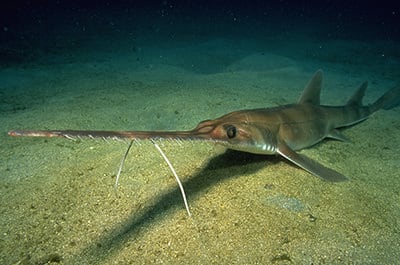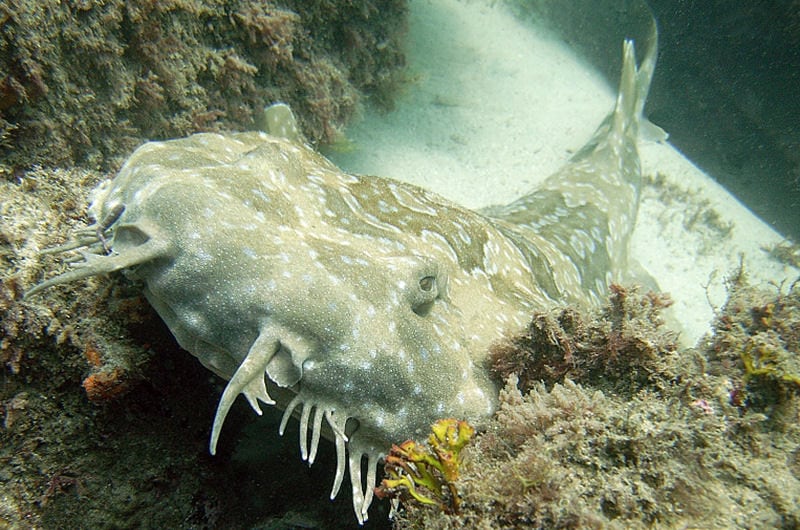The Evolution of Sharks
The class of cartilaginous fish separated from the class of bony fish about 440 million years ago. The 970 species of cartilaginous fish are divided into sharks, skates, rays and chimeras. Sharks and rays occur in the sea from the deep sea to the shallow water zones. Some species also live temporarily or permanently in freshwater. Chimeras live primarily in the deep sea. Most species are hunters, but some feed on plankton. Due to their slow reproduction, well over half of all cartilaginous fish are on the Red List of Endangered Species.
Photo © Shark Foundation / BluePlanetArchive.com / Unsplash

Photo © Shark Foundation
Evolution of Sharks
The evolution of sharks can often only be followed by looking at their fossilized teeth and other sparse fossil finds. The cartilaginous skeletons of sharks only fossilize under extremely favorable conditions. More common findings include secondarily ossified skeletal parts such as jaws and skulls.
The oldest sparse fossil finds stem from the Paleozoic era. These early sharks, or shark species, were usually rather small. In their phylogeny the sharks experienced several flowering phases. Until the Cretaceous period (about 100 million years ago) freshwater sharks were more common than in the present. Today sharks, with few exceptions, live in the sea.
Although only about 970 species of cartilaginous fish have survived to this day, these are very successful. The more than 500 shark species currently known have colonized all areas of life in the water, from the deep sea to rivers, and have developed an amazing variety of forms.

Photo © Shark Foundation
Megalodon
The Megalodon, or scientifically correct term: Carcharocles megalodon, was probably the largest predatory shark that ever swam the oceans. It lived from about 18 million years in the middle Miocene period and disappeared again in the lower Pliocene era about 5 million years ago. Although the Megalodon is often referred to as the ancestor of the great white sharks because of its tooth shape, this is only speculation based on the current state of knowledge. Compared to the great white shark, which reaches a length of 6-7 meters, the Megalodon was a true giant and might have reached a length of about 16, maybe even 18 meters. Its range of distribution included temperate zones worldwide.

Photo © Tom Haight
Plankton Feeder, Shellcracker and Hunters
Nutrition Types
Sharks have not only developed an enormous diversity in terms of appearance but have also developed very different methods of feeding.
Plankton Feeders
Some shark species such as whale sharks, basking sharks and the very rare megamouth sharks have specialized in eating plankton. They follow the plankton blooms and often swim at the water surface with their mouths wide open to filter the plankton. This is very risky for them nowadays, as they are often hit by boats and seriously injured.
Shellcrackers
Some shark species, especially bottom-dwelling sharks, have specialized in cracking mussels and crabs. In order to be able to break up these hard chunks more easily, their teeth are fused to form very stable chewing plates.
Hunters
Most shark species are hunters and mainly eat fish. These are the forms we recognize at first sight as sharks. These include reef sharks, makos, blue sharks and tiger sharks.

Photo © Simon Pierce
Giant and Dwarf
The biggest sharks are the whale sharks, which can grow up to 18 m long. They are peaceful plankton feeders and are often found swimming on the surface with their mouths wide open, filtering plankton. The only place so far where adult whale sharks are regularly sighted in large numbers is the Galapagos Islands. However, whale sharks are found in temperate zones around the world. Larger aggregations of juveniles up to 9 m are found for example in Mozambique, Tanzania, Mexico or Madagascar during plankton blooms.
The smallest sharks are the lantern sharks, which are at home in the deep sea. The smallest shark is therefore also the dwarf lantern shark (Etmopterus perryi), which fits on the palm of a hand. Dwarf lantern sharks are very rare and little is known about them. They live at a depth of about 300 - 500 m in the Caribbean off Colombia and Venezuela.

Photo © BPA
Is that a shark?
Often this question can be answered with a yes, even if this aquatic creature does not look at all like we imagine a classic shark to be.
The most bizarre shark forms are found among deep-sea sharks, such as the frilled shark.






















